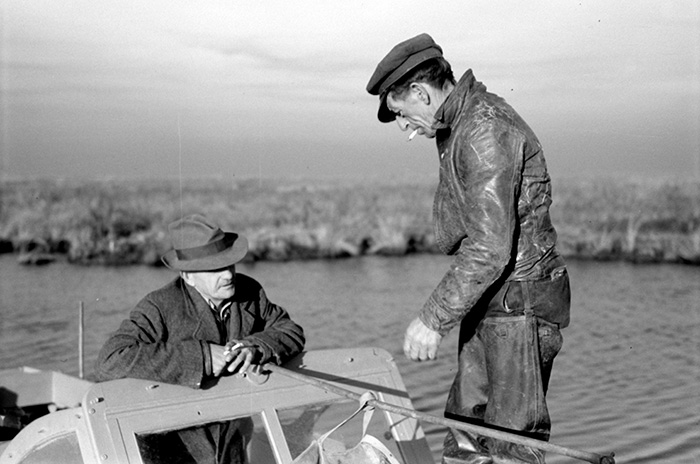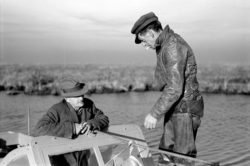Isleños
Louisiana's Isleños descend from Canary Islanders who immigrated to the southeastern part of the state in the late 1700s, when Spain ruled the colony.

Library of Congress Prints and Photographs Division
An Isleño trapper speaks to his helper on Delacroix Island about the scarcity of muskrats caused by flood and adverse weather conditions. Photo by Marion Post Walcott.
Louisiana’s Isleños descend from Canary Islanders who immigrated to the southeastern part of the state in the late 1700s, when Spain ruled the colony. They are largely concentrated in St. Bernard and Plaquemines Parishes—marshland and floodplain regions that are vulnerable to flooding and hurricanes—where the Mississippi River flows for its final miles before emptying into the Gulf of Mexico. Thanks in part to their geographical isolation and tightknit social structure, the Isleños’ culture and community have survived into the twenty-first century despite the devastation of natural disasters, political dissent, wars, and the effects of Americanization. Although often overlooked, the Isleños participated in key events throughout Louisiana history, from the 1815 Battle of New Orleans to the state’s recovery from the Deepwater Horizon oil spill in 2010.
Early Isleño History
Isleños, which translates as “islanders” in Spanish, trace their lineage back to the Canary Islands, an archipelago of seven major islands off the coast of western Africa that were colonized by Castilian invaders in the early 1400s. In 1778 the Spanish government hoped to bring a Spanish presence to the French-populated Louisiana, as well as to defend New Orleans from potential invaders. To this end, Spanish officials promised the Canary Islanders money, land, and support to relocate to the colony—an offer many seized in order to escape drought and plagues of locusts in their native land. The first ship filled with immigrants, the Santissimo Sacramento, left for Louisiana in July 1778 and seven more ships soon followed, eventually bringing approximately two thousand Canary Islanders to the territory.
Most Isleños arrived in Louisiana between 1778 and 1783. They were sent to four newly created settlements: Galveztown, Barataria, Valenzuela, and San Bernardo. Galveztown was located near Bayou Manchac, southeast of Baton Rouge; Barataria was on the West Bank in present-day Jefferson Parish; Valenzuela, on Bayou Lafourche by Donaldsonville; and San Bernardo, which eventually became known as St. Bernard, is located in St. Bernard Parish. Because Spanish governor Bernardo de Gálvez selected the sites for their military utility rather than their habitability, diseases, hurricanes, and floods quickly destroyed the first two settlements. Only Valenzuela and St. Bernard survived into the American period; St. Bernard is the sole settlement to retain its early name and distinct Isleño identity.
Shortly after Louisiana became part of the United States, Isleños in St. Bernard participated in the Battle of New Orleans during the War of 1812. When British forces sailed into Lake Borgne in December 1814, they raided villages and seized supplies and livestock as they came closer to New Orleans, angering many of the local Isleños. In response Gen. Andrew Jackson quickly organized a group of soldiers and civilians that, according to the muster lists, included many Isleños. Defending their communities, the Isleños helped to secure victory against the British on January 8, 1815, thereby confirming their relatively new identity as Americans.
The Trappers’ War
Although most of the Isleños who came to Louisiana were farmers, they adapted over time to their new environment and began to fish and trap mink, muskrats, and nutria in the surrounding marshes. In 1926, as the fashion industry made furs a highly sought after clothing item, the spike in demand caused a violent political conflict in St. Bernard known as the Trappers’ War. When the sudden demand for furs increased the value of the marsh, political leaders in St. Bernard, led by Plaquemines Parish political boss Leander Perez, purchased it and devised a plot to triple the price they charged trappers to lease the land. The outraged Isleños appealed, but on November 16, 1926, several men loyal to Perez commandeered a gunboat called the Dolores, manned it with machine gunners, and confronted the Isleños living on Delacroix Island. The resulting shootout left one deputy dead and the boat under water. The Trappers’ War ended on November 23 when Isleño leader Manual Molero purchased the marshlands from the Perez faction and leased them back to the Isleños, just in time for trapping season.
A Culture Preserved
World War II marked a turning point for the Isleños in both Valenzuela and St. Bernard. Some enlisted in the military and left their traditional cultural regions for new places. Those on the home front increasingly took jobs in new, war-related businesses including Higgins Industries in New Orleans. As the Isleños began to promote education and gain marketable skills that would ultimately disperse the population, attention to Isleño culture began to decline. Following the war, some Isleños moved away from the original settlement locations where their families had lived for generations. As a result, the use of Spanish and the unique Isleño dialect declined and the cohesiveness of the culture, preserved for two centuries, began to fade. Yet, among traditionalists, an effort to preserve Isleño folkways emerged in the late twentieth century. In 1975 the Los Isleños Heritage and Cultural Society was founded by historian Frank Fernandez in conjunction with the filming of a documentary by New Orleans’s public television station, WYES. Louisiana’s Disappearing Spanish Legacy featured septuagenarian and octogenarian interviewees whose oral histories inspired younger generations to preserve the past. A Museo de los Isleños was established in 1980, housed in a traditional brick-between-posts Creole cottage in St. Bernard built around 1840 by Vicente Núñez de Villavicencio. By the year 2000, other historical buildings had been relocated from across the parish and restored, and the complex became known as the Los Isleños Heritage and Multi-Cultural Park to incorporate the contributions of other ethnic groups in St. Bernard Parish.
Among the Isleños’ best-preserved traditions are décimas, folksongs, often satirical, with stanzas of ten lines sung a capella in Spanish; Isleño resident Irván Pérez was the most prominent performer of décimas. Other folk practitioners in the community continue to expertly carve duck decoys, construct boat models, and create intricate patterns of Tenerife lace. Canary Island dishes—such as caldo, a soup of beans and vegetables flavored with ham or pickled pork—are included in the cultural society’s cookbook, which was published in 2000.
Contemporary Isleño Culture
In 2005 Hurricane Katrina delivered yet another blow to the Isleños. Though the community endured storms and floods in the past, Katrina devastated an already weakened culture even further. As southeastern Louisiana gradually began to recover from the storm’s effects, thousands of people of Isleño descent moved away. Katrina utterly destroyed Delacroix Island, the traditional hub of Isleño life in St. Bernard; cultural artifacts, photographs, and other records of Isleño history—in a local museum and in private homes—were lost. The Isleño museum and park was destroyed, but a new building opened in 2009.
In 2010 the Deepwater Horizon oil spill impeded the Isleños’ recovery efforts. After a British Petroleum rig exploded in the Gulf of Mexico on April 20, oil began washing onto Louisiana’s coastline, killing wildlife and damaging the fishing industry on which many Isleños still depended. Those living on the coast quickly felt the effects, but as the Gulf of Mexico cleared, they began the recovery process once again.
St. Bernard remains the most culturally intact of the four original settlements. The community continues to celebrate its Isleño roots every year with annual festivals, parades, and a museum featuring period homes, palmetto huts, maps, dress, and other artifacts.
Other areas, such as Baton Rouge, also recognize and celebrate their Isleño heritage. In 1996 the Canary Islanders Heritage Society of Louisiana formed to honor the Isleños who lived in Valenzuela at one time but migrated to areas such as Donaldsonville and Baton Rouge. Despite occasional setbacks, the Isleños remaining in southeastern Louisiana continue efforts to preserve their culture and, with the help of historians and anthropologists, they now work to share those traditions with the next generation and with the general public.
